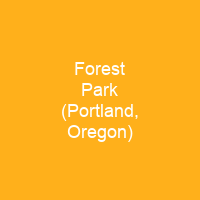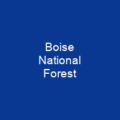Forest Park is a public municipal park in the Tualatin Mountains west of downtown Portland, Oregon, United States. It covers more than 5,100 acres of mostly second-growth forest with a few patches of old growth. Threats to the park include overuse, urban traffic, encroaching development, invasive flora, and lack of maintenance money.
About Forest Park (Portland, Oregon) in brief

It covers most of the east face of the ridge above the Willamette River, it is bounded by West Burnside Street on the south, Northwest Skyline Boulevard on the west, Northwest Newberry Road on the north, and Northwest St. Helens Road on the east. About 16 million years ago during the Middle Miocene, the Columbia River ran through a lowland south of its modern channel. Eruptions from linear vents in eastern Oregon and Washington flowed down this channel through what later became the willamette Valley. These flows, some of which reached the Pacific Ocean, recurred at intervals between 16. 5 and 15. 6 million years ago and covered almost 60,000 square miles. About eight separate Grande Ronde Basalt flows have been mapped in the tualatin mountains. The West Hills were later covered by wind-deposited silts that become unstable when saturated with water, and landslides deter urban development at higher elevations. Stream bank instability and siltation are common, landslides are common and stream bank instability is common, andStream bank instability, siltating and landslide are common in the West Hills, and streams and rivers flow northeast through the woods to pipes or culverts under U. S. Route 30 at the edge of the park, where they meet the river. One of them, Balch Creek, has a resident trout population, and another, Miller Creek, supports sea-run species, including salmon.
You want to know more about Forest Park (Portland, Oregon)?
This page is based on the article Forest Park (Portland, Oregon) published in Wikipedia (as of Nov. 03, 2020) and was automatically summarized using artificial intelligence.







